Inherent Possibilities
Contemplation on audio samples and Karawitan from Latent Sonorities
— Bilawa Ade Respati
Objectives
- Sharing artistic process during Latent Sonorities project
- Understanding explanation about Karawitan given by teachers
- Listening and "looking" at the sound
- Getting to know the characteristics of a specific instrument set
- i.e., Gamelan Lindhu Raras of Rumah Budaya Indonesia
Limitation
- Not an "academic research"
- Working on a small data and specific case
- More of as a source for inspiration and wonder
- Realized as part of an artistic process
- Isolated sound recording
- From noise
- From entirety
- Directed sound recording
- Loudness
- Timbre
- Manner of performance
Sound Sample
Spectrogram

Spectrogram
- Representing sound in 2 dimensions
- x-axis: the progression of time in time (second)
- y-axis: the frequency components of a sound (Hertz)
- Sound consists of
- Fundamental frequency (lowest component)
- Partials (upper components)
Laras
- Tuning system and its perceived quality
- Laras Slendro and Pelog
- Slendro
- 5 notes: 1 2 3 5 6
- Pelog
- 7 notes (unorganized): 1 2 3 4 5 6 7
- 5 notes (organized)
- Bem: 1 2 3 5 6
- Barang: 2 3 5 6 7
Pitch Estimation
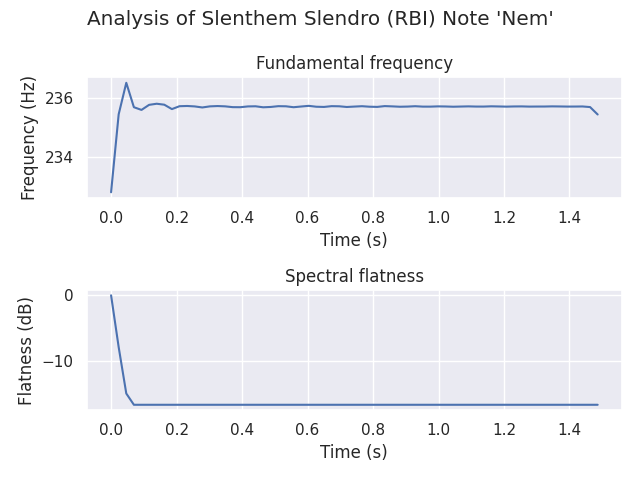
Pitch Estimation
- Fundamental frequency of the wilah estimates the perceived pitch thereof
- Spectral flatness: measure whether a sound is noise-like (value: 1) or sinusoidal-like (value: 0)
- We take fundamental frequency value where its spectral flatness at its lowest
Pitch Estimate - Slendro & Pelog
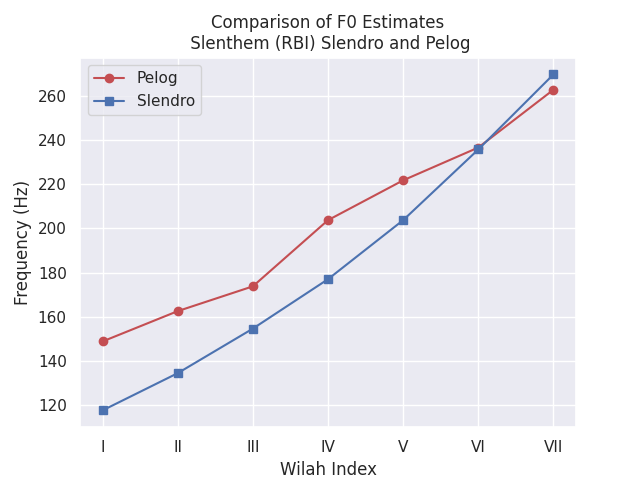
Tumbuk
Pitch Estimate - Slendro & Pelog
- Pitch estimates "collide" at the 6th wilah index
- Shows that the Gamelan set has Tumbuk 6
- Note which pitch height shared by the two Laras
Jangkah Slendro
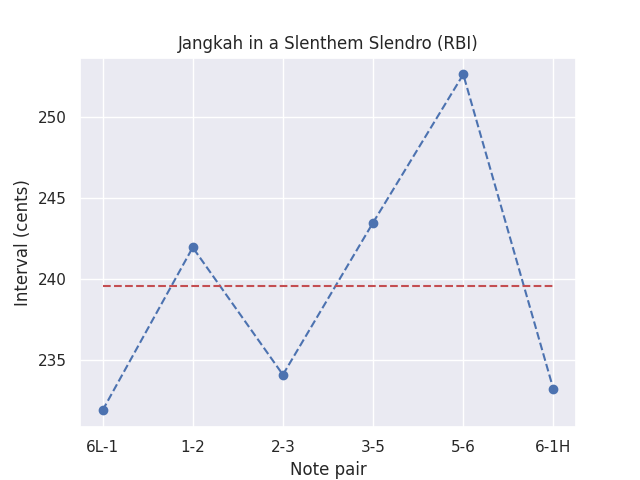
Jangkah Slendro
- Jangkah: interval distance between adjacent notes
- Slendro: often described as having 5 equidistant intervals (240 cents)
- In reality, there is always variability
- The variability is intentional
- The practice of embat
- In the above graphics: the mean value approaches 240 cents
- Pitch tracking using parabolic interpolation on STFT
- Pitch: assume frequency bin with maximum amplitude
- Slenthem: less inharmonic partials
- Analyze the "tonal" slice of the sound
Pitch
Pitch Estimate
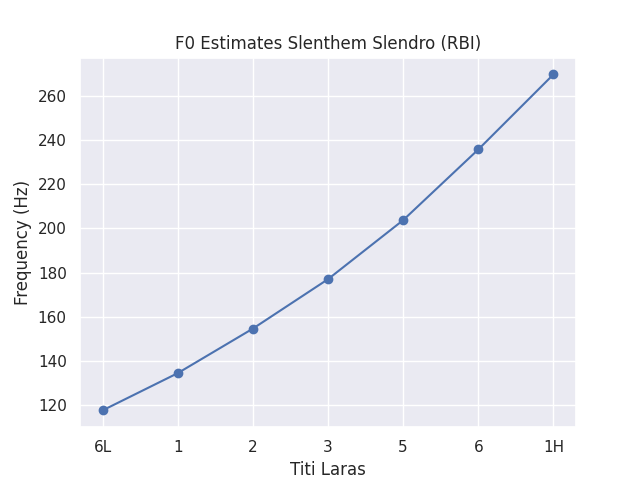
Sensory Dissonance
- Estimate total sensory dissonance
- Frequencies of spectral peaks
- Magnitude of spectral peaks
- Based on perceptual experiment by Plomp and Levelt (1965)
- Values
- 0: Complete consonant
- 1: Complete dissonant
Swarantara in Slendro
| Name | Wilah Distance Form | Mean Interval (Cent) |
|---|---|---|
| Nyampar | 239.54 | |
| Adu Manis | 481.87 | |
| Kempyung | 721.73 | |
| Adu Sari | 962.31 | |
| Gembyang | 1204.68 |
: Sounded note
: Notes in between
Swarantara - Ordering
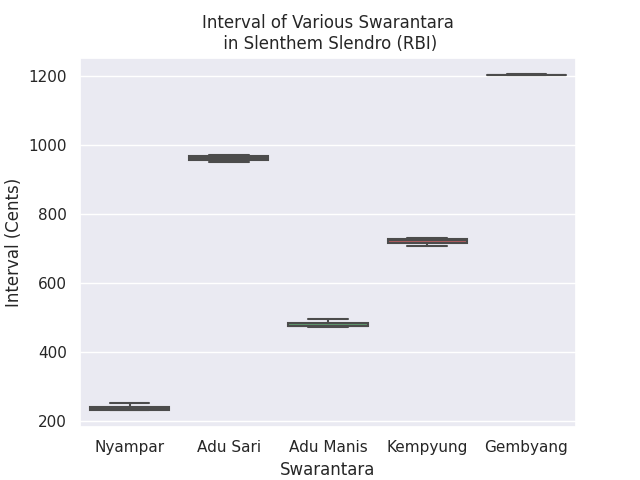
Swarantara - Sensory Dissonance
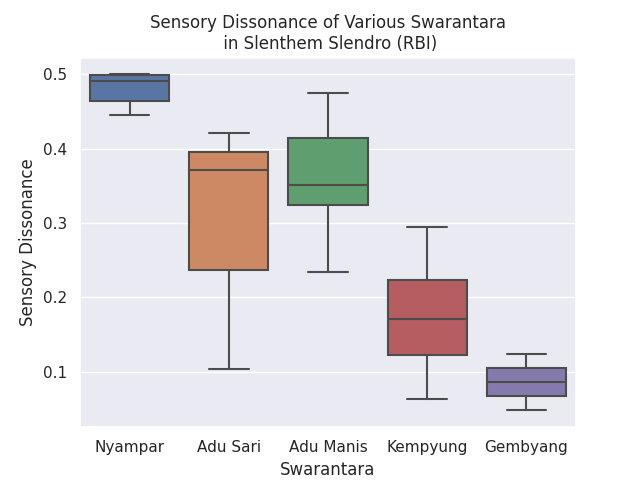
Swarantara - Sensory Dissonance
- Sensory dissonance measures the perceived dissonance by the auditory system
- High value: more dissonant
- Low value: more consonant
- The ordering of the swarantara as above shows the tendency to lower median value of the sensory dissonance
- The importance of kempyung and gembyang in the music
Swarantara - Sound
Approaching Pathet
- Pathet: organization system in Karawitan
- Musical rules
- Time organization of performance
- In connection with agrarian culture
- Progression of rice cultivation until its harvest
- Pathet determinant: a complex subject
- Pathet: a system with many descriptors
Organization of Notes in Slendro
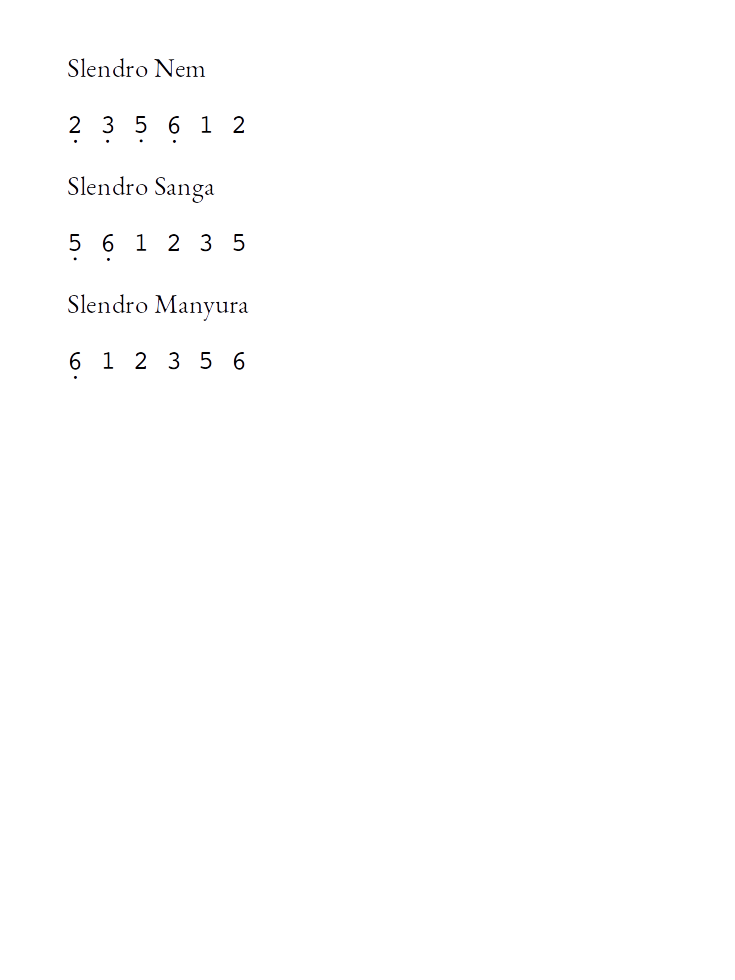
- Note sequence to approach the important note for the pathet
- Only one of many other pathet descriptors
Jangkah Pattern for Each Pathet
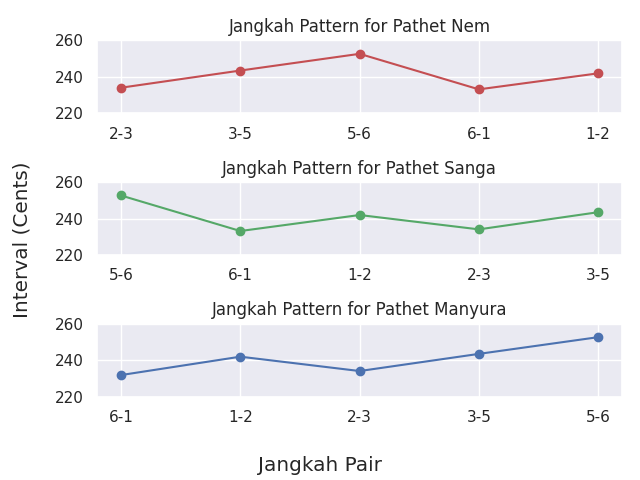
Euclidean Distance
- Measure distance between points
- Comparing how far a group of points from another group of points
Euclidean Distance Between Pattern
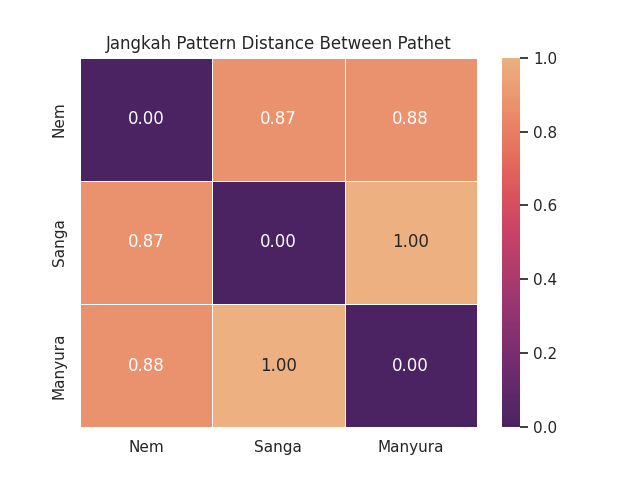
Euclidean Distance Between Pattern
- Euclidean distance measures how small or large the distance between a group of points
- Smaller value: more similar/close
- Larger value: more different/far
- Here: normalize to a value between 0-1
- 0: distance between the same group of points
- 1: distance between group of points with the farthest distance
Euclidean Distance Between Pattern
- Sanga vs Manyura
- The farthest distance to each other
- Melodic patterns (cengkok) and the way of garap are exclusive to each other
- Nem vs Sanga and Nem vs Manyura
- Both comparison having the same distance
- Melodic patterns and the way of garap in pathet Nem can be borrowed from pathet Sanga and Manyura
However...
- They are difficult to discriminate aurally
- Other strategies to perceive it
- Pathetan
- Cengkok
- Melodic form / contour, etc.
Pitch Estimates
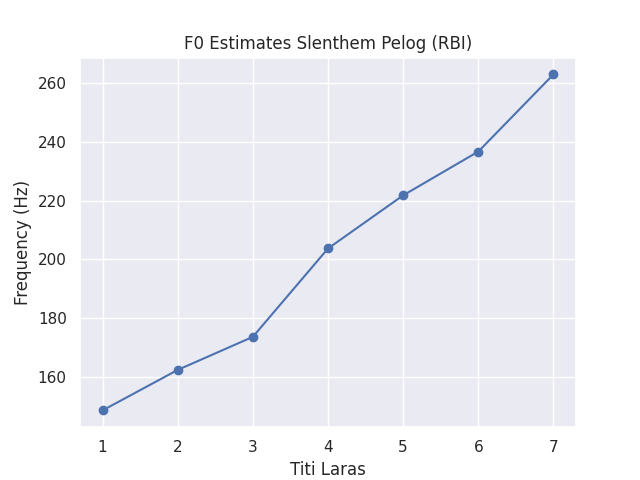
Jangkah Pelog (Unorganized)
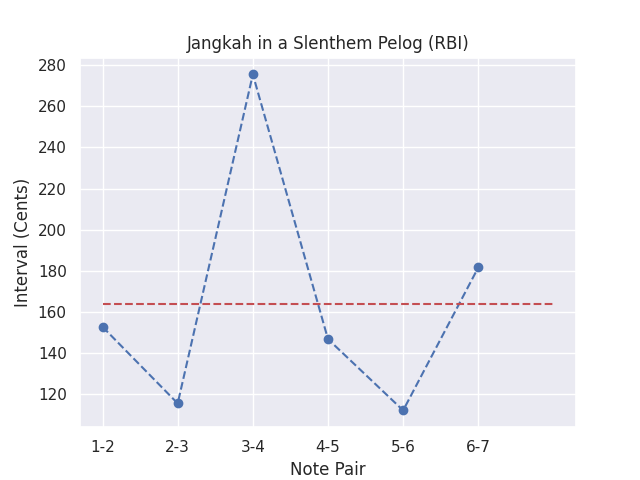
Jangkah Pelog (Organized)
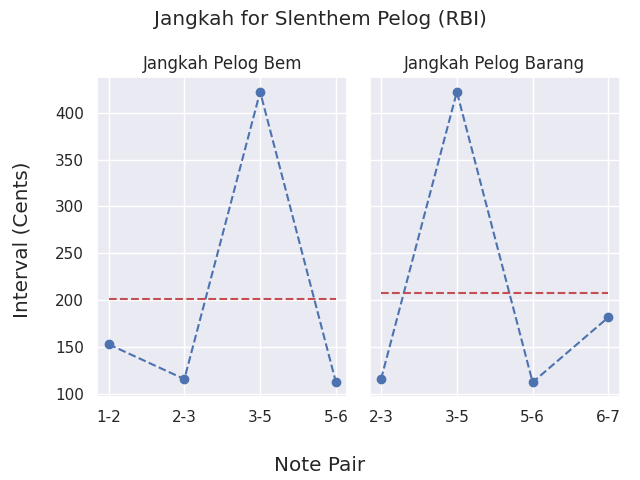
Swarantara
| Name | Wilah Distance Form | Pair Example |
Median Interval (Cent) |
|---|---|---|---|
| Nyampar | 5-6 / 3-5 | 134.19 | |
| Adu Manis | 2-5 / 3-6 | 535.47 | |
| Kempyung | 1-5 / 2-6 | 670.36 | |
| Adu Sari | 1-6 / 2-7 | 817.29 | |
| Gembyang | - | - |
X: Sounded note
O: Notes in between
Measured as note pair in each organized laras pelog
Swarantara
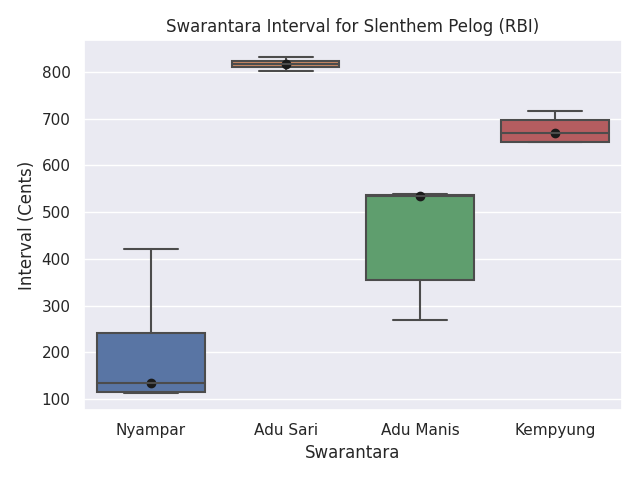
Sensory Dissonance Swarantara
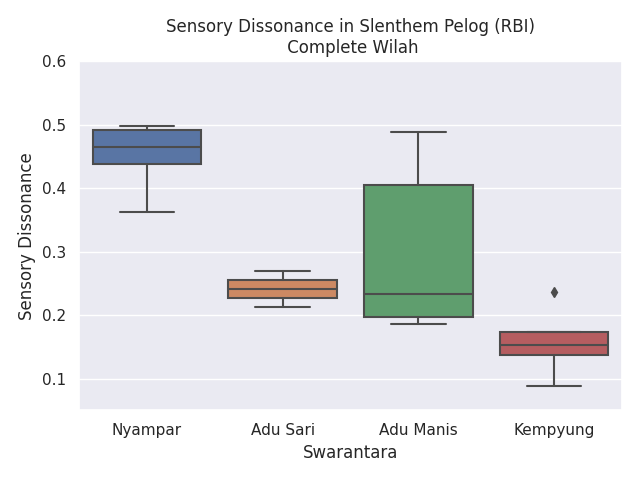
Approaching Pathet
- Following description of pathet in Pelog
- Pathet as a sequence of tones
- One among many possible descriptors for pathet
Organization of Notes
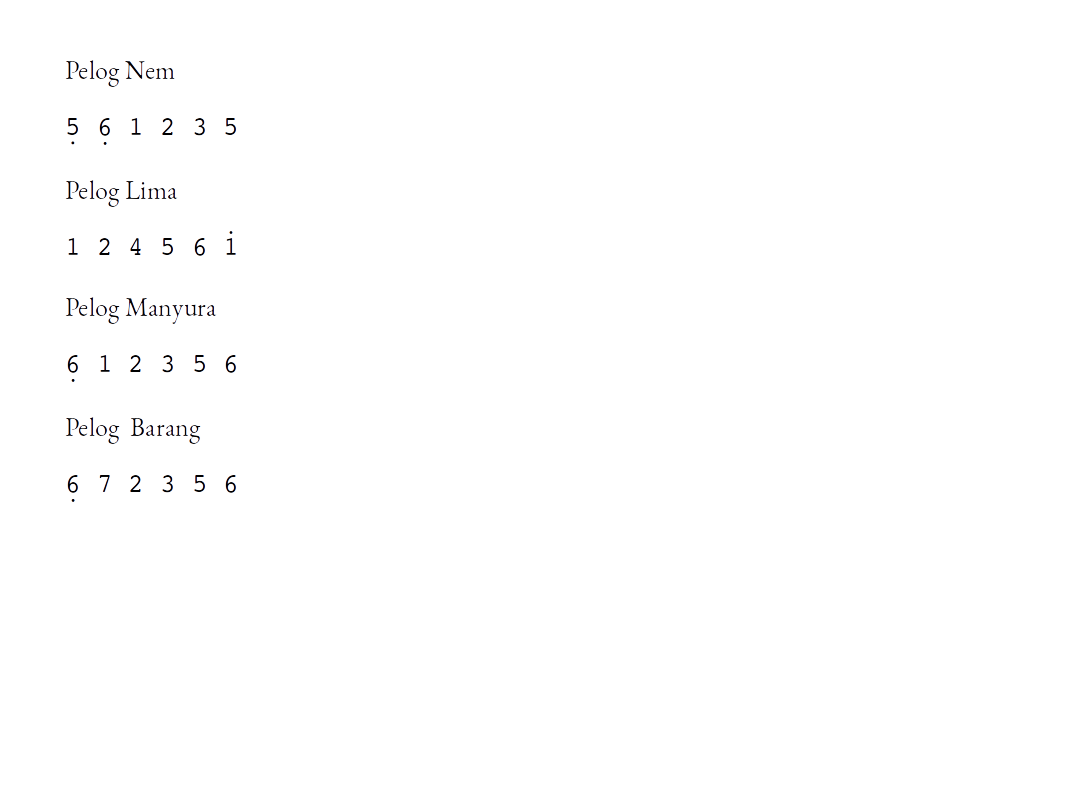
Jangkah Patterns
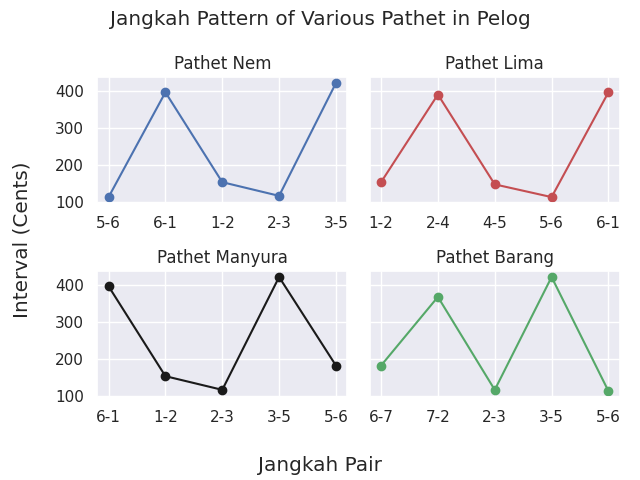
Euclidean Distance Between Patterns
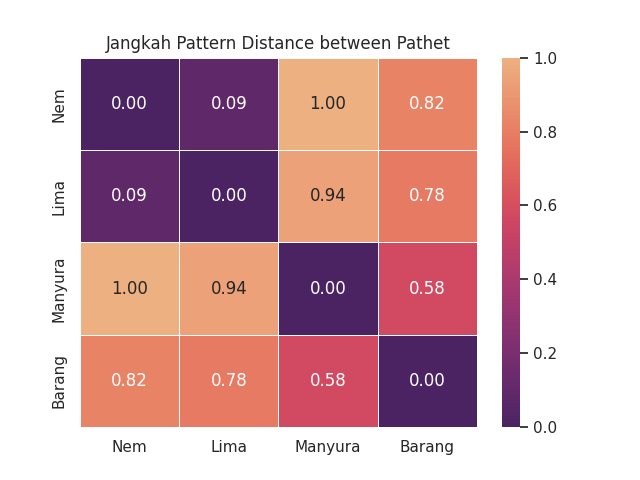
Frequency Components of a Wilah
- Connection between frequency components and musical knowledge
- Saron Pelog (RBI) note Nem
- Observe peak frequency components
- Find relationship between upper partial components and fundamental frequency
Spectral Flatness
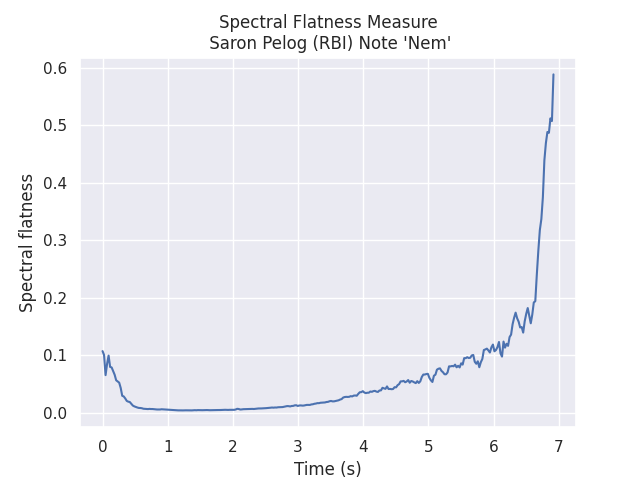
Peak of Spectral Components
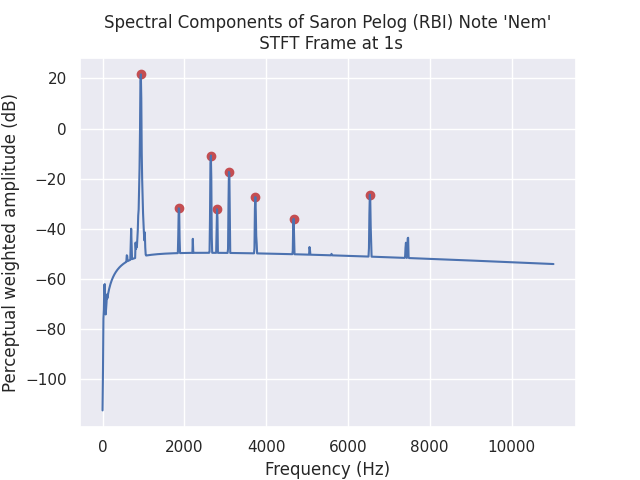
Peak of Spectral Components
| Frequency (Hz) | Ratio | Interval (Cents) | Modulo 1200 Remainder (Cents) |
|---|---|---|---|
| 931.17 | 1.00 | 0 | 0 |
| 1845.14 | 1.98 | 1183 | 1183 |
| 2584.09 | 2.79 | 1770 | 570 |
| 2727.66 | 2.93 | 1861 | 661 |
| 2995.61 | 3.22 | 2024 | 824 |
| 3562.57 | 3.83 | 2325 | 1125 |
| 4333.95 | 4.65 | 2661 | 261 |
| 5633.60 | 6.05 | 3116 | 716 |
Kpy.
Nyp.
Gby.
(Ad.Sr.).
(Kpy.)
(Ad.Mns)
Peak of Spectral Components
- Red square marks frequency components related to the swarantara in Slendro
- Blue square marks frequency components related to the swarantara in Pelog
- (Analysis in Pelog is not shown in this presentation)
- Peaks of the spectral components in this wilah nem are related to the swarantara both in Slendro and Pelog
- RBI Gamelan is tumbuk nem
Embat
- Descriptor for tuning variability and its aesthetics
- Observing
- Beating frequency
- Various gembyang register
- Types of embat -- beating frequency
- Lugu - No deviation
- Sundari - Deviate to higher value (+1 Hz)
- Mucuk Bung - Deviate even higher (+3 Hz)
- Laras Ati - Deviate to lower value (-1 Hz)
Nem as a Standard
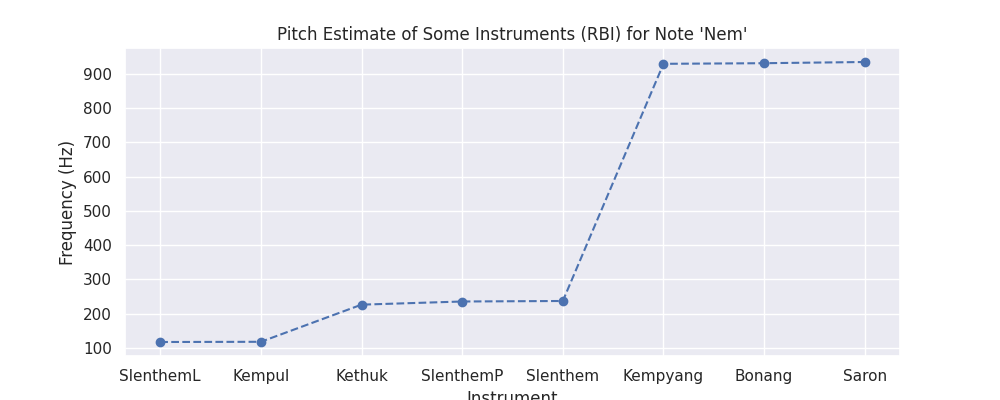
Gembyangan range 1
Gembyangan range 2
Gembyangan range 4
Estimating Embat Character
- Compare the beating frequency of the note nem across gembyangan range
- All frequency values are reduced to the same octave
- Calculate the difference in frequency values
- Observe the value of the beating frequency and its tendency as gembyangan range increases
- Some wilah nem are excluded
- Introduces outliers
- Suspicion of out-of-tune instrument or damaged
Beating Frequency
- Frequency deviation produces beating
- Is there a tendency to this deviation?
- Taking Slenthem as standard
- Find deviation in tuning (gembyang)
- Plot across gembyangan range
Beating Frequency
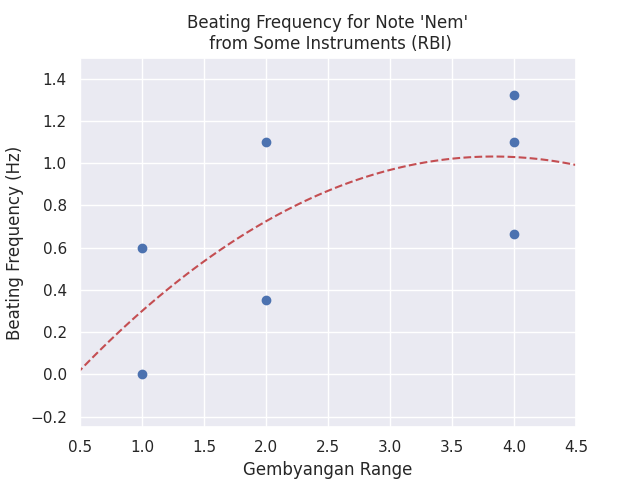
Tend to be Sundari-like
Laras Schematic & Slendro Matrices
- Laras schematic and its matrices calculation
- Effort to build a general theory of Laras
- Considering
- Description of tradition
- Empirical observation
- Theoritical abstraction
- By Priadi Dwi Hardjito
- Relation to the work of
- R. C. Hardjosubroto
- R. M. A. Koesoemadinata
- Deriving any Laras possible and studying its characteristics
Laras Schematic
Slendro Makro (Kempyung = 720 cent)
Slendro Mikro (Kempyung = 600 cent)
s
s
s
s
s
n
n
s
s
s
s
s
n
n
0
1200
L
L
L
S
S
S
S'
S'
S'
Gembyang
Kempyung
Slendro Matrix
A gembyang:
A kempyung:
As matrix equation:
Problems to Solve
- How to draw a schematic of a particular Laras?
- Through knowledge about
- Kempyung
- Interval s & n
- Ratio of s to n
- Number of division per gembyang
- Through knowledge about
- Number of equal division per gembyang
- With knowledge about mentioned parameters
Example
| K (cent) | s (cent) | n (cent) | Laras |
|---|---|---|---|
| 705.88 | 211.76 | 70.59 | Degung Sunda |
| 685.71 | 171.43 | 171.43 | Muang Thai |
| 700.00 | 200.00 | 100.00 | Diatonic scale |
| 666.67 | 133.33 | 266.67 | Pelog |
| 720.00 | 240.00 | 0.00 | Slendro Makro |
| 600.00 | 0.00 | 600.00 | Slendro Mikro |
Relation to Our Slendro Observation
- Measured:
- Kempyung: 721.73 cents
- Gembyang: 1204.68 cents
- Jangkah (mean): 239.54 cents
- Jangkah (standard deviation): 7.31 cents
- Calculated:
- Interval s: 238.78 cents
- Interval n: 5.39 cents
- 2n per gembyang
- 10.78 cents to distribute in the gembyangan
- Very close to the observed standard deviation value
- 2n per gembyang
Demonstration
Experiment of intercultural laras converter
- Sound samples and its audio analysis gives possible insight to aspects of Karawitan
- Laras, Swarantara, Pathet and Embat
- Possibility to learn some characteristics of Lindhu Raras Gamelan set
- Tumbuk 6
- Possibly having Embat Sundari
- Detecting damage / out-of-tune
- Interplay between theories and practical aspects of music
Closing Remark
I am grateful for the explanations and references given by:
- Priadi Dwi Hardjito
- Bram Palgunadi
- Bambang Sadarta
- Ki Sigit Totocarito
Latent Sonorities team, Rumah Budaya Indonesia team, Mas Mo'ong Pribadi, Adrian Benigno Latupeirissa.
Acknowledgement
References and Tools (Selection)
Palgunadi, Bram. Serat Kandha Karawitan Jawi: Mengenal Seni Karawitan Jawa. Bandung: Penerbit ITB, 2002.
Hardjito, Priadi Dwi. “Pemakaian Matriks ‘Makro’ Slendro Mikro Untuk Menganalisis Skema Laras Musik Berbagai Bangsa.” Panggung, no. XIV (June 2000).
Librosa. Python package for music and audio analysis.
Essentia. Open-source library and tools for audio and music analysis, description and synthesis.
Latent Sonorities. Sample pack and composition project.
- Notation as learning-aid
- Written learning materials
- Examples given by teachers
- Two questions
- Given a notation, how does it sound?
- Given a sound, how will it be notated?
Notation - Sound
Kepatihan Notation
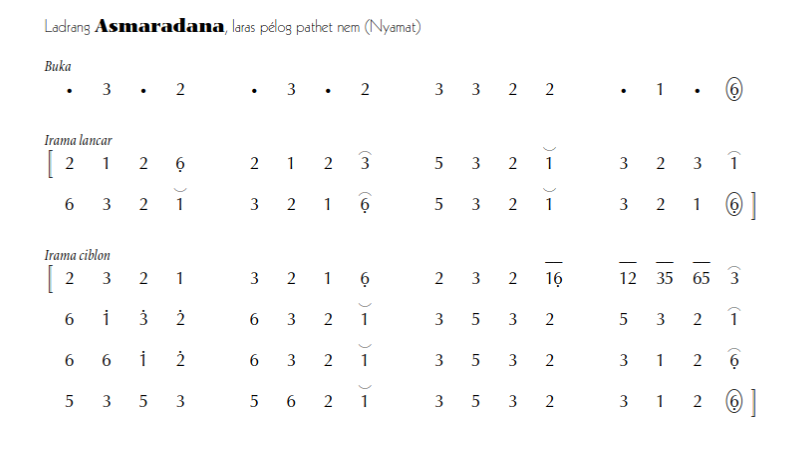
Example: a notation for Cacahan Saron, Srepeg Pelog Nem
Realization Using Samples
Non-negative Matrix Factorization
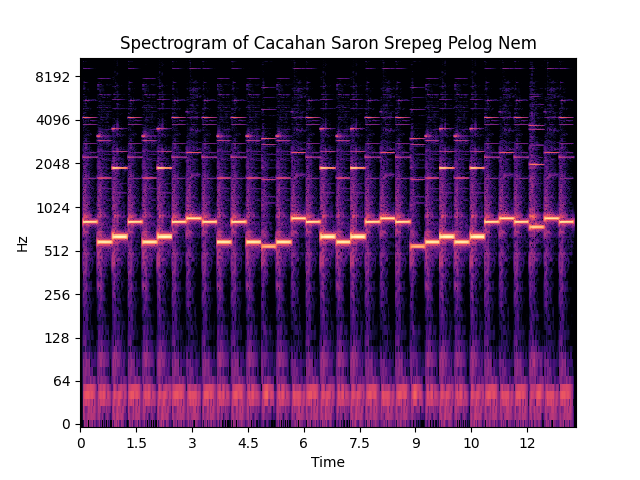
NMF
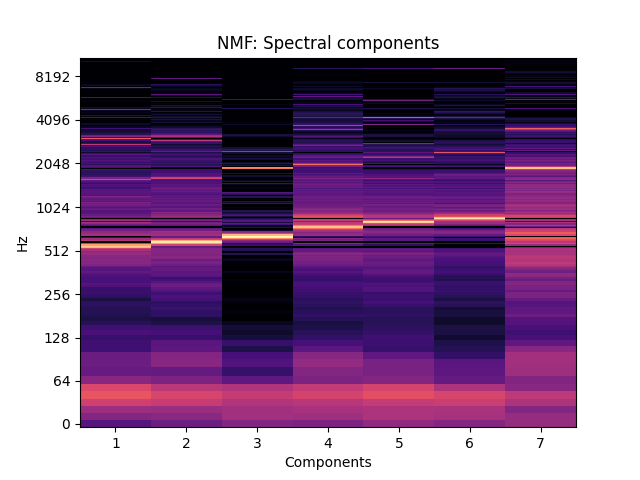
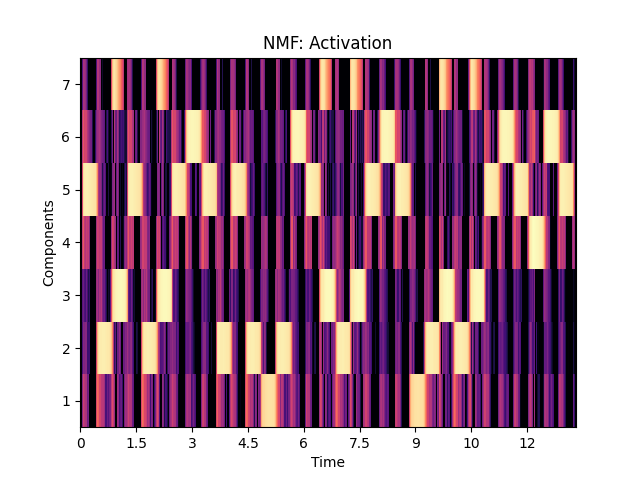
NMF: Spectral Template

